In this post
Now that we have discussed plant nutrition we will move on to the nutrition required by humans. The nutrition obtained from our food can be used in many ways within our bodies. There are three main reasons that we require food: it provides minerals that are essential for growth and the repair of tissues; it is a source of energy for our bodies; and it helps us to fight disease and keep our bodies healthy.
Having a balanced diet is essential for the human body to function properly and remain healthy. It requires a varied range of nutrition and in the correct proportions. A diagram has been provided which will give you an idea of these proportions:
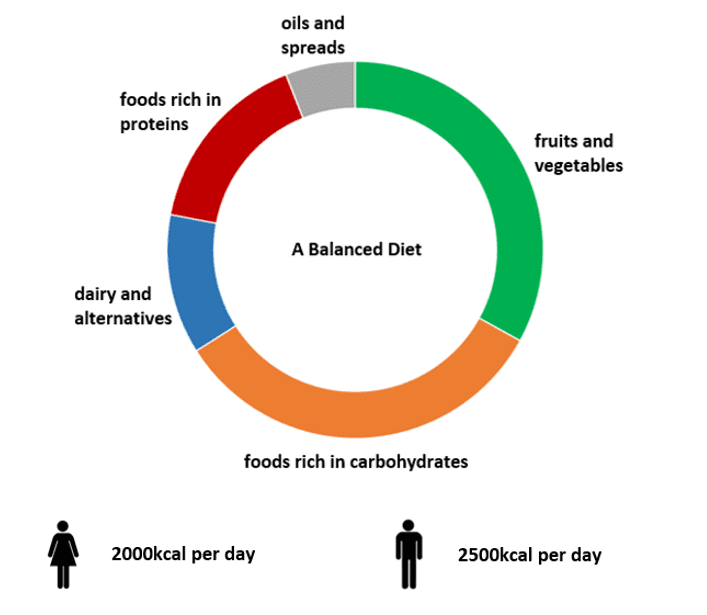
A balanced diet is dependent upon consuming correct proportions of carbohydrate, lipid, protein, vitamins, minerals, water and dietary fibre. There are certain foods that are higher in these essential requirements than others (for example, foods high in carbohydrates include wholewheat bread, potatoes, pasta and brown rice etc.).
Adult reference intakes
You may have seen reference intakes on many labels of the food you eat. Previously, they were known as ‘guideline daily amounts’ (GDAs). These are merely guidelines rather than strict rules to adhere to; this is because different types of people will require different amounts of nutrients. Adult reference intakes are normally based on an average-sized woman doing a general amount of physical activity (unless the label states otherwise). Considering this, a table has been provided below to indicate this type of person’s reference intakes as part of a healthy balanced diet.
| Energy: | 8,400 kJ/2,000kcal |
| Total fat: | 70g |
| Saturates: | 20g |
| Carbohydrate: | 260g |
| Total sugars: | 90g |
| Fibre | 28g |
| Protein: | 50g |
| Salt: | 6g |
On a food label, you will be provided with the amounts of different nutrients that the food contains, along with the food’s energy content. Look at the image for an example of the type of information you may see on a food label.
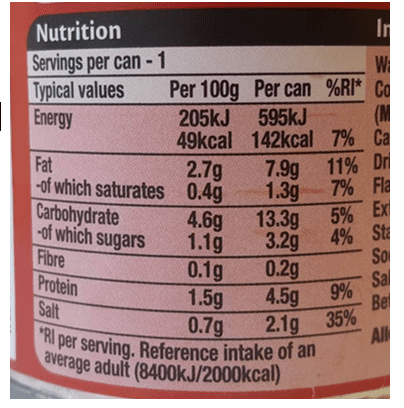
Energy content in foods is measured in kilojoules (kJ). As you will see from the labels on different types of food, certain foods provide higher or lower quantities of energy and this is dependent on the proportions of carbohydrates, lipids and proteins in the food.
A gram of oxidised lipid produces around 39kJ, a gram of carbohydrate around 17kJ and a gram of protein produces around 18kJ. As you can see from these figures, lipids provide us with the highest energy content in foods. As a result, foods that are high in lipids (such as butter or nuts) provide a large amount of energy; and foods which have a low percentage of lipids (such as fruit and vegetables) provide a lower amount of energy.

The amount of energy a person requires depends on their activity levels, gender, age and if they are pregnant. Look at the table here which illustrates the average energy required for different people.
| Age/Gender/Occupation | Energy (kJ) required per day |
|---|---|
| New-born baby | 2,000 |
| Child (2 years old) | 5,000 |
| Child (6 years old) | 7,500 |
| Girl (12-14 years old) | 9,000 |
| Boy (12-14 years old) | 11,000 |
| Girl (15-17 years old) | 9,000 |
| Boy (15-17 years old) | 12,000 |
| Female adult with a desk job | 9,500 |
| Male adult with a desk job | 10,500 |
| Heavy manual worker | 15,000 |
| Pregnant woman | 10,000 |
| Breastfeeding woman | 11,300 |
As you may be able to tell from the table above, the greater the mass of the person the more energy they require. That is why men tend to require more energy than women. The above figures are averages only; therefore, a male adult desk worker who is greater in weight than the average male adult will require more energy. This applies to pregnant women as well; they mainly require more energy due to the extra weight they have to carry.
However, the recommended energy requirement is not the only factor that varies with a person’s gender, age and pregnancy. For example, due to menstruation some young women lose a fair amount of blood each month and this can result in anaemia; meaning that they will require an extra amount of iron in their diet. Another example would be during pregnancy, as extra iron and calcium can improve the growth of the foetus so the woman may need to increase her intake of food products that are high in these.
Even when a person is not undergoing any physical activity, such as when they are sleeping, they still require energy. This energy is used for their heartbeat, regulating their temperature (keeping warm) and allowing nerves in their body to send messages to other body functions. However, if we regularly consume more kJs than we require then the excess will be stored in our bodies as fat.
Now that we have discussed the types of food that make up a balanced diet, we will now individually discuss carbohydrates, lipids, proteins, vitamins, minerals, water and dietary fibre.
Carbohydrates
As previously discussed, carbohydrates are made up of simple sugars. Carbohydrates can be split into three classes: monosaccharides, disaccharides and polysaccharides. The image below highlights foods that are particularly high in carbohydrates.
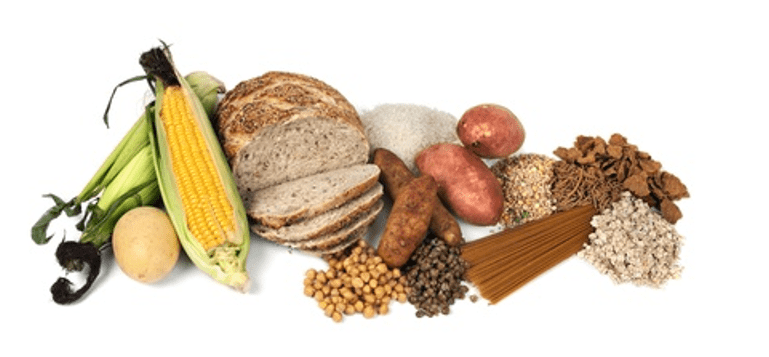
Lipids (fats and oils)
Lipids are made up of fatty acids and glycerol and are a high source of energy for the body. There are two different forms of fatty acids that we will discuss here: unsaturated fats and saturated fats.
Certain types of lipids are unsaturated and are generally known as the healthier fat compared to saturated fats. The fatty acids in unsaturated fats contain double bonds. They are more common in plant oils than anything else.
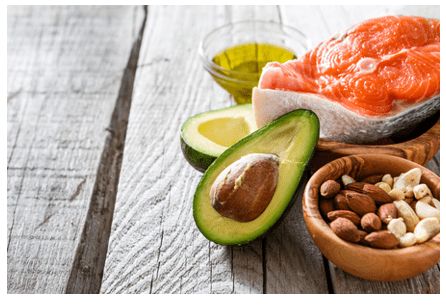
Saturated fats, however, are more common in foods that have been obtained from animal sources. Their fatty acids contain no double bonds. These often include butter, eggs, meat, cheese and oily fish which are all rich in animal fats
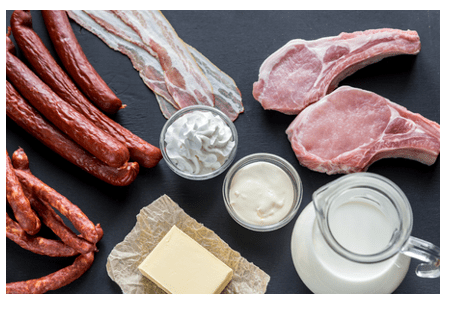
Lipids are an essential part of our diet, however, too much can be harmful to our bodies. Our bodies begin to store fat when we take in more energy than we require. The dangers with too many lipids in the diet is especially when we have too much cholesterol (a lipid compound) or saturated fat in our diet, as when obtained in excessive amounts they have both been linked to heart disease.
Proteins
As previously discussed, proteins are made up of a range of amino acids. There are 20 different sub-units of amino acids that link together in long chains to make proteins. These chains consist of amino acids that are twisted into spirals with cross links holding all the chains together. Proteins make up the second largest fraction of our body. They can be found in most foods but animal products, such as cheese, eggs, fish and meat, and some plant products, such as beans, peas and nuts, generally contain higher amounts of protein.
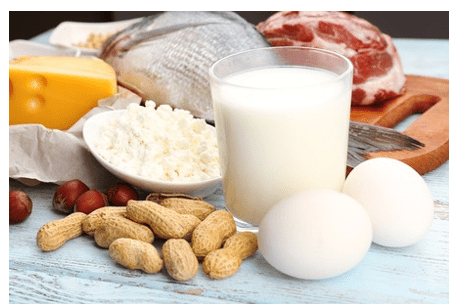
Although protein is an essential nutrient for our bodies, it is recommended by doctors that the maximum daily intake of protein should be around 70g. This means that the human body does not require too much protein to remain healthy. However, as mentioned in an earlier chapter, protein deficiency diseases (such as kwashiorkor) tend to develop in less economically developed countries.
Vitamins
Vitamins were not known about until the early part of the twentieth century when lab experiments were conducted on rats in regards to their nutritional intake. Some of the rats were fed a diet that consisted solely of carbohydrates, lipids and proteins and the others had the same but with milk added to their daily intake. The rats that were given no milk became ill and died whereas the others grew normally. There are certain chemicals contained in milk known as vitamins. The different types of vitamins were identified by the effect they caused on the body when there was a deficiency in them and so were given letters to distinguish between them.
There are 13 essential vitamins that the human body requires. Vitamins are required in small amounts but are nonetheless essential nutrients. If a person consumes a varied and balanced diet, then they should get all the vitamins they need. These essential vitamins are:
- Vitamin A
- Vitamin C
- Vitamin D
- Vitamin E
- Vitamin K
- Vitamin B1 (thiamine)
- Vitamin B2 (riboflavin)
- Vitamin B3 (niacin)
- Vitamin B5 (pantothenic acid)
- Vitamin B6 (pyroxidine)
- Vitamin B7 (biotin)
- Vitamin B9 (folate)
- Vitamin B12 (cobalamin)
Each vitamin has a special function within the body, but we are going to focus on vitamins A, C and D.
Vitamin A (also known as retinol), in good quantities, can be found in foods such as cheese, eggs, low-fat spreads (margarine etc.), milk, oily fish and yoghurt (as well as the foods illustrated in the next diagram). This vitamin has several important functions which include:
- Helping a person’s vision in dim light as this vitamin is required to make a light-sensitive chemical which is in the retina of the eye.
- Keeping certain linings on the body healthy, for example the skin and the lining of the nose.
- Helping a person’s immune system function properly as it fights infections
The recommended daily vitamin A requirement for an adult man is 0.7mg and for an adult woman it is 0.6mg. A vitamin A deficiency can cause night blindness which prevents a person from being able to see well in dim light. In more serious cases it can cause a condition called xerophthalmia which, if left untreated, can lead to blindness.
Although it is an essential vitamin, too much vitamin A can also be harmful. Some studies have shown that having more than an average of 1.5mg of vitamin A over a prolonged period has several harmful effects:
- It can affect the bones and their likelihood of fracturing – older women are particularly at risk as they are already more likely to have osteoporosis as they age.
- It can harm an unborn baby if a woman is consuming too much vitamin A whilst pregnant. Therefore, pregnant women should avoid taking vitamin A supplements and eating foods which are high in vitamin A; for example, liver and liver pâté which should not be consumed more than once a week by the average person anyway.
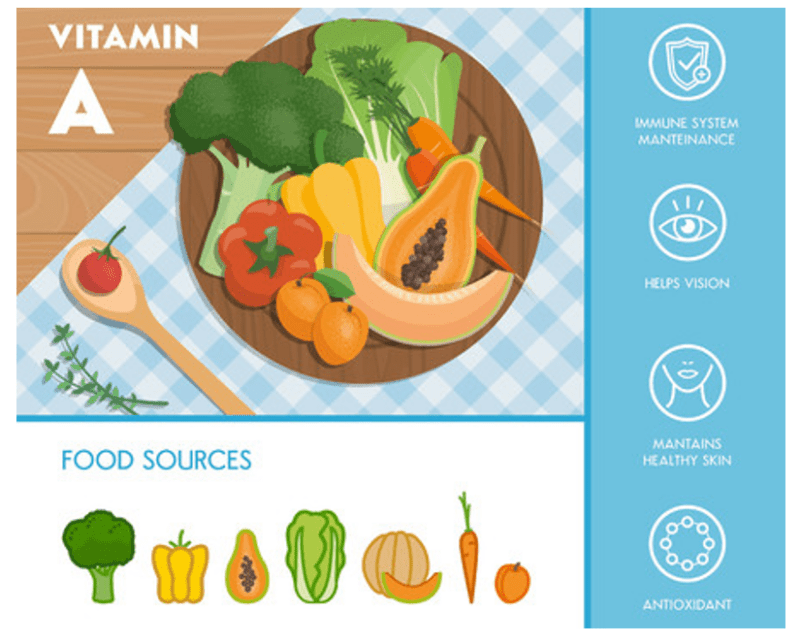
Vitamin C (also known as ascorbic acid), in good quantities, can be found in foods such as strawberries, blackcurrants, broccoli, brussels sprouts, orange juice, oranges, potatoes and red and green peppers. This vitamin has several important functions which include:
- Making fibres which bond cells together for connective tissue. Connective tissue provides support and structure for other tissues and organs within the body
- Helping wounds to heal.
- Helping protect cells and keep them healthy.
The recommended daily vitamin C requirement for an adult is 40mg. An intake of vitamin C is required daily as the body is not able to store any. A deficiency in vitamin C can lead to a disease known as scurvy. Scurvy is a disease where wounds fail to heal properly. Bleeding in this case can occur in various places of the body but is more common in the gums.
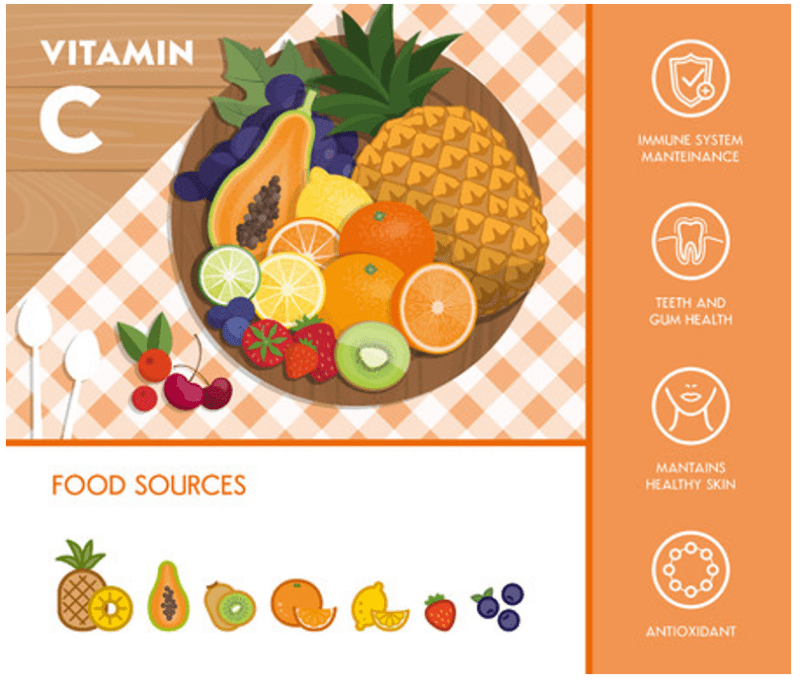
Vitamin D increases intestinal absorption and helps to regulate the levels of calcium and phosphate within the body. During the spring and summer months people can obtain most of their required vitamin D from sunlight onto their skin. However, between the autumn and winter months people do not obtain any vitamin D from sunlight and so it must be obtained from foods such as egg yolks, fortified foods (most fat spreads and a few breakfast cereals), liver and oily fish (herring, mackerel, salmon and sardines).
The recommended daily amount of vitamin D for a baby between 0-1 year of age is 8.5-10mcg. The recommended daily amount of vitamin D for children older than 1 year and adults is 10mcg per day (this includes breastfeeding and pregnant women).
Vitamin D can sometimes be hard to obtain as it is only found in a small number of foods. Therefore, it is recommended that everyone should consider taking a supplement, especially within the autumn and winter months. The amounts of recommended vitamin D supplements are:
| Breastfed babies 0-1 year | 8.5-10mcg daily |
| Babies fed infant formula 0-1 year | Infant formula is fortified with vitamin D and so supplements should not be given until the baby is receiving less than 500ml of formula a day |
| Children 1-4 years | 10mcg daily |
| Adults (including breastfeeding and pregnant women) | 10mcg daily |
A deficiency in vitamin D can result in bone deformities in children such as rickets. In adults, it can result in a condition known as osteomalacia which causes bone pain and tenderness.
Consuming too many vitamin D supplements over long periods can result in more calcium being absorbed by the body than can be excreted which causes hypercalcaemia (high levels of calcium in the blood). However, 10mcg per day will be enough for most people so they should try not to exceed this unless otherwise stated by a doctor.
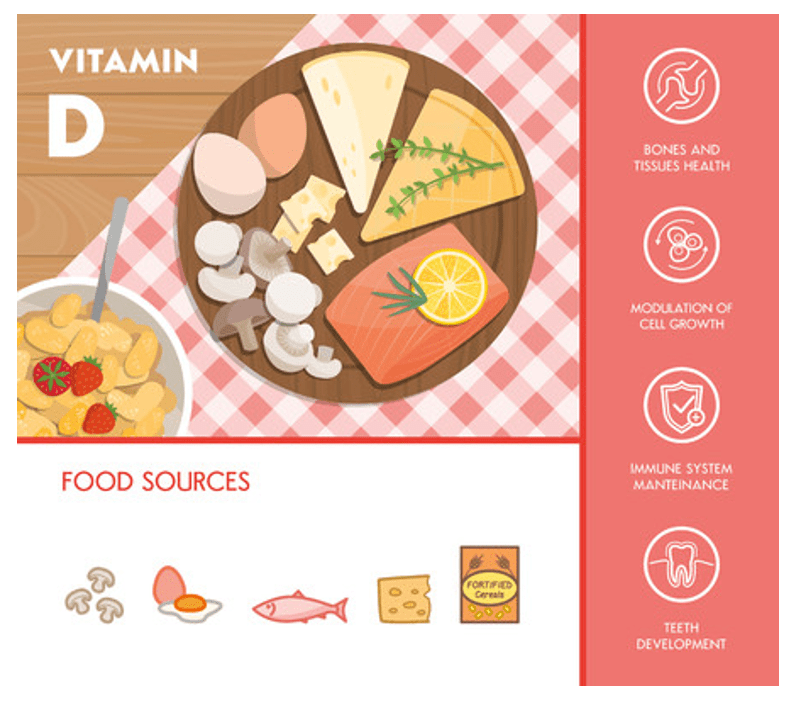
Minerals
Some minerals are present in large amounts within our body (calcium) and some in much smaller amounts (iron); however, they all play an essential role in different bodily functions.
The following diagram has been provided which outlines some of the minerals in the human body and their functions.
| Mineral | Mass in body | Location/role in the body | Foods rich in the mineral |
|---|---|---|---|
| Calcium | 1000g | The growth of teeth and bones | Bread, dairy products, eggs, fish, green vegetables, wholegrain cereals |
| Iron | 3g | Is part of the haemoglobin in red blood cells which helps the blood carry oxygen around the body | Bread, eggs, vegetables, lentils, liver, red meat |
| Magnesium | 30g | Is found inside cells and helps make bones | Green vegetables |
| Potassium | 140g | Mostly located inside cells. It helps to regulate blood pressure, activate enzymes and transmit electrical impulses | Fruit, nuts, legumes, potatoes, vegetables, whole grains |
| Phosphorus | 650g | Is part of many chemicals, for example DNA, and is responsible for helping to make teeth and bones | In most foods |
| Sodium | 100g | Found in the blood and helps control blood pressure and regulate the function of muscles and nerves | In most foods and common salt |
| Zinc | 2g | Found in cells. Helps the immune system work sufficiently, the development of cells, wound healing and the sense of smell and taste | Dairy products, legumes, nuts, shellfish, wholegrain cereals |
The recommended daily intake of the minerals that have been mentioned are:
| Mineral | Recommended daily intake for the average adult |
|---|---|
| Calcium | 1,000mg |
| Iron | 18.5mg |
| Magnesium | 410mg |
| Potassium | 4,000mg |
| Phosphorus | 1,000mg |
| Sodium | 2,400mg |
| Zinc | 15mg |
Like vitamins, people can develop deficiency diseases. Mineral deficiency diseases have a range of symptoms. The table below has been provided to highlight these and their effects.
| Mineral | Effects caused by deficiency |
|---|---|
| Calcium | In children, a deficiency in calcium can cause poor bone development which can result in a disease known as rickets (rickets can also be caused due to a lack of vitamin D in a child’s diet). In adults, it can result in a condition called osteopenia, which if left untreated can develop into osteoporosis. |
| Iron | Iron deficiency over a long period can cause anaemia (a low level of haemoglobin in the blood). |
| Magnesium | Magnesium deficiency is uncommon as the kidneys can normally keep magnesium from leaving the body through urine. However, a deficiency can be caused by certain medications or health conditions (such as alcoholism). This deficiency can lead to abnormal rhythms of the heart, muscle cramps and seizures. |
| Potassium | A severe potassium deficiency can cause paralysis of the muscles and heart arrhythmias. |
| Phosphorus | Phosphorus deficiency can cause anxiety, fatigue, fragile bones, loss of appetite, stiff joints, irritability and irregular breathing. |
| Sodium | Sodium deficiency can cause headaches, confusion, muscle cramps, nausea and fatigue. |
| Zinc | Zinc deficiency over long periods can cause diarrhoea, alopecia (loss of hair), impotence and a prolonged process in wound healing. |
Dietary fibre and water
As well as the other important elements of a balanced diet that we have mentioned, water and dietary fibre are also essential components.
Dietary fibre is a type of carbohydrate that is not digested in the small intestine of humans. Instead, it passes through the small intestine and into the colon where it is then fermented by certain bacteria. Dietary fibre still provides the body with a small amount of energy but not as much as other types of carbohydrates that are digested. Instead of providing the body with energy, dietary fibre’s most important function is to help protect the digestive system and keep it healthy.

Dietary fibre is found exclusively in plant based foods. Examples of these types of food include beans, fruit and vegetables, lentils, nuts and seeds, oats, wholegrain cereals and cereal products.
The reference intake (RI) of dietary fibre for the average adult is 24g. Achieving the recommended RI helps to:
- Normalise bowel movements and soften your stool
- Prevent constipation and maintain bowel health
- Control blood sugar levels
- Lower cholesterol levels
Water makes up around two-thirds of the total mass of the human body. Drinking enough water to stay hydrated is therefore a vitally important part of a healthy diet as it is essential for life.
It is commonly recommended that the average human should consume eight glasses of water a day. However, the daily amount of water required for our bodies does in fact vary with age, gender, size, activity levels and even the climate in which we live in.
Water has many important functions within the body. These include:
- Cell life
- Chemical and metabolic reactions
- Regulating body temperature
- Transporting nutrients and removing waste
Your recommended intake from water can also be obtained from certain foods and other liquid based drinks; not just water itself. Many fruits and vegetables have a high water content and liquid based drinks can include tea, coffee, diluted juice, milk etc.



